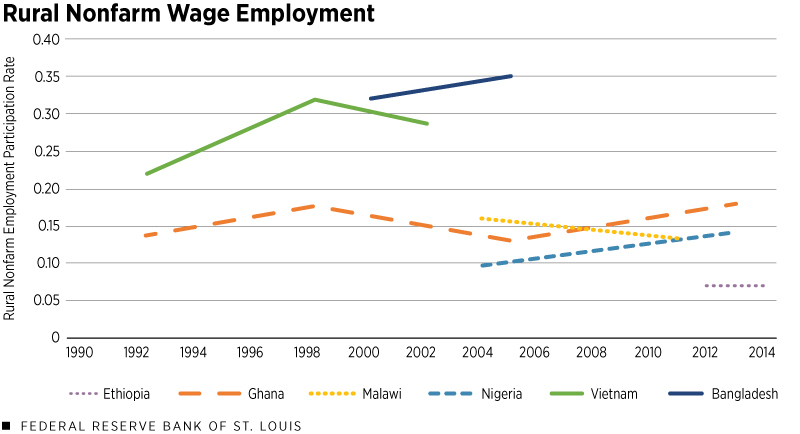How to Jump-Start Industrialization in Sub-Saharan Africa
KEY TAKEAWAYS
- Most sub-Saharan nations have such low per capita incomes that it would take decades of double-digit growth to attain U.S. living standards.
- Nations that industrialize successfully often begin with small-scale efforts and progress to mass-producing heavy industrial goods.
- African countries could follow this development pattern with government-provided infrastructure and other support.
When considering income disparities across nations, the differences often can be striking, particularly for nations in the sub-Saharan region of Africa. Per capita income in many poor countries like these is 30 to 50 times smaller than in the U.S. In sub-Saharan Africa, 38 of 48 countries had gross national income (GNI) per capita levels below $2,300 in 2019, while GNI per capita was $65,850 in the U.S., according to data from the World Bank’s World Development Indicators database.
Generations of economists have studied economic development and given policy suggestions to officials in poor countries in Africa and elsewhere, but the disparities remain. To catch up to U.S. living standards, they would need to grow at about 11% per year for 40 to 50 years—an almost impossible standard that only China has come close to achieving in recent history.
The New Stage Theory of Development
The commonality between successful Asian countries’ industrialization (such as China’s rapid rise in the past 40 years) and successful European nations’ industrialization (such as the British Industrial Revolution in the 18th* and 19th centuries) is that these economies all went through three key stages during their industrialization, according to the New Stage Theory of Development (NST):See Wen.
- Proto-industrialization, which features massive numbers of workshops in rural areas with small-scale production of basic consumer goods for long-distance trade
- A first industrial revolution, which features mass production of labor-intensive, light consumer goods for domestic and international markets
- A second industrial revolution, which features mass production of capital-intensive, heavy industrial goods
The first stage is very important but has been largely ignored by development economists. During this initial stage, rural farmers or poor households in urban areas use their free time to manufacture simple products and engage in long-distance trade. This raises their income and nurtures the formation of an increasingly unified market and primitive production networks, while developing entrepreneurship and labor skills. Proto-industrialization in early European history is a phenomenon well-documented by economic historians. England went through proto-industrialization from the 1600s to the 1760s before jump-starting its first industrial revolution from the 1760s to 1830s. China went through proto-industrialization during the first 10 years of its economic reform between 1980 and 1990.
During the second stage, large-scale factory systems become prevalent for light industries such as textiles, processed food, toys and furniture. This mass-production stage is labor-intensive, export oriented and benefits from poor countries’ comparative advantage in cheap labor. Mass production in the second stage is profitable only because proto-industrialization has created a large enough market and distribution networks for consumer goods.
Finally, the expansion of light industry in the second stage facilitates the formation of a large enough market for heavy industrial goods—such as means of transportation, energy, steel and heavy equipment. This is not only because the income of workers needs to be high enough to purchase big-ticket items such as automobiles, but because mass production of heavy industrial goods is profitable only after the second stage creates a mass-production chain to support their demand. Also, only through the second industrial revolution does agricultural machinery become cheap enough to support agricultural mechanization, ultimately resolving the food security problem that troubles all nations in the early stage of development.
What’s Wrong with Conventional Development Theories?
The essence of this sequential developmental process is to gradually build the size of the market to support mass production of more and more sophisticated and capital-intensive industrial goods, and thus exploit the economies of scale. This sequential process overcomes the problems associated with the lack of skilled workers, the scarcity of capital and barriers to technology adoption encountered by many developing countries at various developmental stages.
Yet most development theories teach poor agrarian nations to begin their industrialization by:
- Building advanced, capital-intensive industries such as chemical, steel and automobile manufacturing
- Setting up modern financial systems such as a floating exchange rate, free international capital flows and fully fledged privatization of state-owned properties and natural resources
Such theories can lead to chaos, instability, developmental traps, colossal debt and financial crisis, as has happened in other parts of the world.
Lessons for Development in Sub-Saharan Africa
Since gaining independence from various European colonial powers, sub-Saharan African countries have tried to industrialize by following conventional development theories. Many sub-Saharan countries rely on exporting minerals and other natural resources in exchange for foreign manufactured goods. Others have tried liberalizing their financial markets or setting up advanced heavy industries that were against their comparative advantages in labor-intensive manufacturing and not competitive in the world market.
For example, in Ghana, after the country gained independence from Great Britain in 1957, the government emphasized the development of large, state-owned, capital-intensive manufacturing to break dependence on imports and promote technological progress. However, this increase in industrial output did not increase gross domestic product (GDP); GDP growth declined from 4.8% in 1961 to 1.1% in 1966.
In 1983, a new structural adjustment program attempted to privatize state-owned enterprises and liberalize the economy. The industrial sector did subsequently grow from 1984 to 1988, but growth later fell from a high of 17.6% in 1985 to 1.3% in 1994.
The structural adjustment program also triggered a decline in Ghana’s prosperous textile industry (which previously employed 27% of the manufacturing labor force) because these trade reforms increased textile imports and there was a shortage of foreign exchange for raw material imports.
Data from the RIGA database of the United Nations’ Food and Agriculture Organization suggest that many sub-Saharan countries have not yet started or finished their proto-industrialization stage. In the figure below, the share of farming households participating in nonfarm wage employment,For example, employment in small-scale manufacturing. an indirect measure of proto-industrialization, is shown for several countries.

SOURCE: United Nations Food and Agriculture Organization RIGA database.
NOTES: The data show rural nonfarm wage employment over 22 years. While developing Asian countries such as Bangladesh and Vietnam have experienced notable increases in rural nonfarm employment, poorer African countries have not experienced such gains.
In some newly emerging Asian economies, such as Vietnam and Bangladesh, about 30% of rural households were participating in nonfarm wage employment in the early- to mid-2000s (29% in 2002 in Vietnam and 35% in 2005 in Bangladesh). Rates of nonfarm wage employment in poor African countries, such as Ethiopia, Ghana, Malawi and Nigeria, remain between 5% and 18%.
In 2019, the GNI per capita in Bangladesh and Vietnam was $1,940 and $2,590, respectively. GNI per capita was $850 in Ethiopia, $2,220 in Ghana, $380 in Malawi and $2,030 in Nigeria. Although GNI per capita in Nigeria and Ghana is relatively high for the region, these economies are more dependent on income from oil and other natural resources than Bangladesh and Vietnam, according to data from the World Bank’s Development Indicators.
On the other hand, when China engaged in full-fledged proto-industrialization in the 1980s and kick-started its first industrial revolution around the early 1990s, the number of village workers as a fraction of the total rural labor force increased greatly. These workers went from 9% of the labor force in 1978 to 23% by 1988, and then increased to 30% by 2000.See Wen, p. 41.
The Chinese experience in recent decades and the British industrial revolution in the 17th and 18th centuries imply that proto-industries must reach 40% to 50% of total agricultural value added—or about 25% to 30% of total rural labor force in their employment share—to spark a full-fledged first industrial revolution, or to render mass production of light consumer goods profitable and internationally competitive. See Wen, p. 123.
Based on this criterion, Vietnam and Bangladesh should possess the market conditions for supporting mass-production technologies in light industries like textiles. Indeed, these two countries are currently the largest clothing exporters after China, according to data from the World Trade Organization. But countries such as Ethiopia, Ghana, Malawi and Nigeria do not appear ready to support mass-production technologies in light industries, since their textile and clothing exports are very low.
Policy Implications for Africa
Based on the New Stage Theory of Development, we have a few policy suggestions for countries where rural manufacturing is not yet prevalent. Policymakers should provide every means possible to enhance proto-industrialization, which will help their countries embark on a healthy path of economic development.
The goal is to absorb as many rural households as possible into small-scale manufacturing workshops to increase their income and create a primitive supply chain and a disciplined labor force. This is one of the critical steps for nurturing a mass market to support full-fledged mass-production in light industries.
Governments should provide the necessary infrastructure and social capital to allow farmers to organize themselves into firms and send their goods to distant markets. Part of the income earned could be used to support government initiatives such as building local roads and canals, which reduce transportation costs and are a better use of resources than large projects like high-speed trains—which are better suited to the second industrial revolution stage.
Successfully creating proto-industrial supply chains, commercial distribution networks and competition between proto-industrial firms would eventually help give rise to large firms that mass produce light industrial goods such as textiles. A nation can also be more likely to attract large foreign firms that outsource their labor-intensive manufacturing industries by using subsidization policies such as providing ports, roads and free land as incentives.
* This article has been updated to correct the start of British industrialization.
Reference
Wen, Yi. The Making of an Economic Superpower: Unlocking China's Secret of Rapid Industrialization. World Scientific Publishing Co., 2016.
Endnotes
- See Wen.
- Proto-industrialization in early European history is a phenomenon well-documented by economic historians. England went through proto-industrialization from the 1600s to the 1760s before jump-starting its first industrial revolution from the 1760s to 1830s. China went through proto-industrialization during the first 10 years of its economic reform between 1980 and 1990.
- Also, only through the second industrial revolution does agricultural machinery become cheap enough to support agricultural mechanization, ultimately resolving the food security problem that troubles all nations in the early stage of development.
- For example, employment in small-scale manufacturing.
- See Wen, p. 41.
- See Wen, p. 123.
Views expressed in Regional Economist are not necessarily those of the St. Louis Fed or Federal Reserve System.
For the latest insights from our economists and other St. Louis Fed experts, visit On the Economy and subscribe.
Email Us



